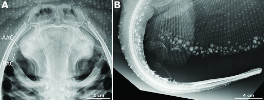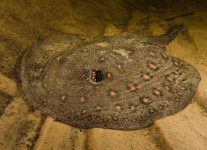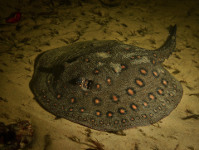Potamotrygon amandae
Loboda & De Carvalho, 2013
Classification: Elasmobranchii Myliobatiformes Potamotrygonidae
Reference of the original description
Systematic revision of the Potamotrygon motoro (Müller & Henle, 1841) species complex in the Paraná-Paraguay basin, with description of two new ocellated species (Chondrichthyes: Myliobatiformes: Potamotrygonidae). Neotropical Ichthyology, 11(4), 693–737
Systematic revision of the Potamotrygon motoro (Müller & Henle, 1841) species complex in the Paraná-Paraguay basin, with description of two new ocellated species (Chondrichthyes: Myliobatiformes: Potamotrygonidae). Neotropical Ichthyology, 11(4), 693–737
Image of the original description
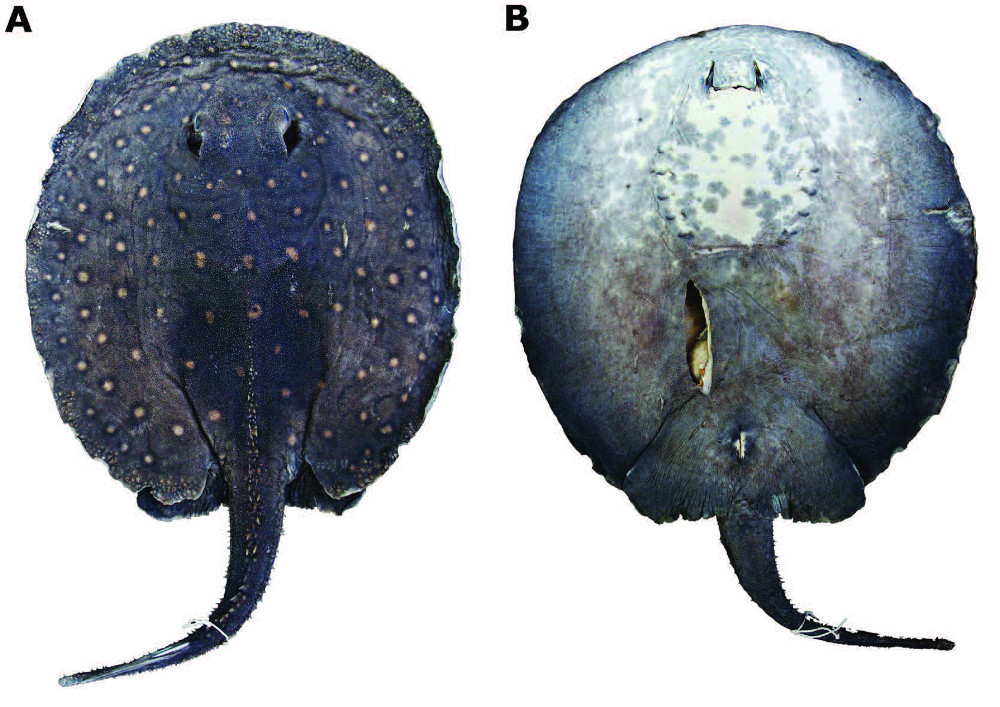
Potamotrygon amandae, n. sp. Dorsal (a) and ventral (b) views of holotype, MZUSP 110910, adult female, 341 mm DW, Paraguay River. In: LOBODA, T.S. & De Carvalho, M.R. 2013: Systematic revision of the Potamotrygon motoro (Müller & Henle, 1841) species complex in the Paraná-Paraguay basin, with description of two new ocellated species (Chondrichthyes: Myliobatiformes: Potamotrygonidae). Neotropical Ichthyology, 11 (4): 693-737

Potamotrygon amandae, n. sp. Dorsal (a) and ventral (b) views of holotype, MZUSP 110910, adult female, 341 mm DW, Paraguay River. In: LOBODA, T.S. & De Carvalho, M.R. 2013: Systematic revision of the Potamotrygon motoro (Müller & Henle, 1841) species complex in the Paraná-Paraguay basin, with description of two new ocellated species (Chondrichthyes: Myliobatiformes: Potamotrygonidae). Neotropical Ichthyology, 11 (4): 693-737
Synonyms / new combinations and misspellings
Potamotrygon cf. amandae
Potamotrygon cf. amandae
Types
Potamotrygon amandae
Holotype: MZUSP: 110910; Paratype: MZUSP: 110904; MZUSP: 111921; MZUSP: 110906; MZUSP: 110909; MZUSP: 110907; MZUSP: 111916; MZUSP: 111920; MZUSP: 110913; MZUSP: 111919; MZUSP: 111917; MZUSP: 111925; MZUSP: 111923;
Potamotrygon amandae
Holotype: MZUSP: 110910; Paratype: MZUSP: 110904; MZUSP: 111921; MZUSP: 110906; MZUSP: 110909; MZUSP: 110907; MZUSP: 111916; MZUSP: 111920; MZUSP: 110913; MZUSP: 111919; MZUSP: 111917; MZUSP: 111925; MZUSP: 111923;
Description :
Citation: Potamotrygon amandae Loboda & De Carvalho, 2013: In: Database of modern sharks, rays and chimaeras, www.shark-references.com, World Wide Web electronic publication, Version 12/2025
Please send your images of "Potamotrygon amandae" to info@shark-references.com
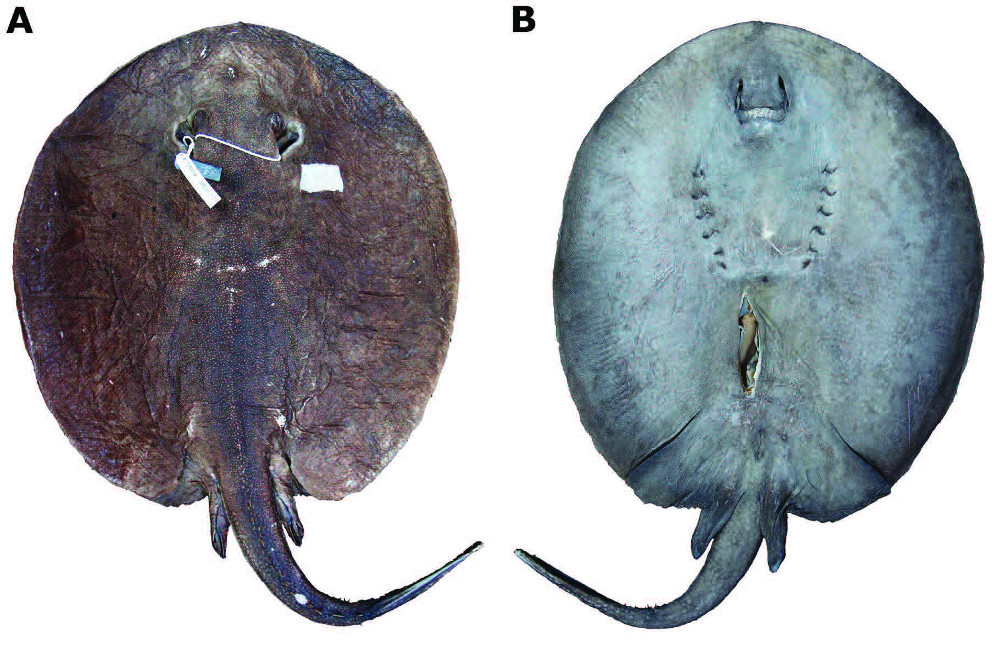
Potamotrygon amandae, n. sp. Dorsal (a) and ventral (b) views of paratype, MZUSP 110904, adult male, 312 mm DW, from Paraná River. In: LOBODA, T.S. & De Carvalho, M.R. 2013: Systematic revision of the Potamotrygon motoro (Müller & Henle, 1841) species complex in the Paraná-Paraguay basin, with description of two new ocellated species (Chondrichthyes: Myliobatiformes: Potamotrygonidae). Neotropical Ichthyology, 11 (4): 693-737

Potamotrygon amandae, n. sp. Dorsal (a) and ventral (b) views of paratype, MZUSP 110904, adult male, 312 mm DW, from Paraná River. In: LOBODA, T.S. & De Carvalho, M.R. 2013: Systematic revision of the Potamotrygon motoro (Müller & Henle, 1841) species complex in the Paraná-Paraguay basin, with description of two new ocellated species (Chondrichthyes: Myliobatiformes: Potamotrygonidae). Neotropical Ichthyology, 11 (4): 693-737
Short Description
Original diagnosis after LOBODA & DE CARVALHO, 2013 [20494]: Potamotrygon amandae, sp. nov. differs from congeners in the Paraná-Paraguay basin, except P. motoro and P. pantanensis, due to its predominantly grayish or dark brown dorsal background color usually with bicolored ocelli on dorsal disc (P. falkneri, P. histrix, P. schuhmacheri, and P. brachyura lack ocelli; some specimens of P. amandae, sp. nov. lack ocelli and have a uniform dark brown or gray dorsal color). A combination of characters differentiates P. amandae, sp. nov. from P. motoroand P. pantanensis: dorsal background predominantly grayish or dark brown (P. motoro with dorsal disc background color gray, dark gray, olive, olivaceous brown, or dark brown, and P. pantanensis with dorsal disc background brown); ocelli, when present, with two colors, with a whitish, light gray or light yellow central area surrounded by a black peripheral ring (P. motoro presents tricolored ocelli with a peripheral dark ring, yellowish or orange center and with an intermediate band, and P. pantanensis presents bicolored ocelli with a beige, orange or dark yellow central area surrounded by a peripheral black ring); ventral disc coloration grayish, covering almost all of ventral disc (ventral color predominantly whitish over central disc in P. motoro and P. pantanensis); dermal denticles differ from P. motoro due to their smaller size and without developed coronal plates in P. amandae,sp. nov., and from P. pantanensis due to their distribution over almost entire dorsal side of disc (in P. motoro and P. pantanensis, dermal denticles do not cover almost entire dorsal disc); greater spiracular length compared to P. motoro and P. pantanensis, with mean 10.1% DW (ranging from 8.2 to 12.8% DW), whereas in P. motoro spiracular mean length is 8.0% DW (ranging from 6.7 to 9.8% DW), and in P. pantanensis mean spiraclular length is 8.7% DW (ranging from 7.6 to 9.6% DW); relatively longer tail, with tail length averaging 82.1% DW, whereas mean tail length is 78.5% DW in P. motoro and 73.4% DW in P. pantanensis; tail relatively more slender in P. amandae, sp. nov., with mean tail width 11.0% DW (ranging from 7.2 to 13.6% DW), whereas in P. motoro and P. pantanensis mean tail width is, respectively,13.4% DW and 13.2% DW (ranging from 10.5 to 14.8% and 11.2 to 15.5% DW, respectively); frontoparietal fontanelle of neurocranium constricted at midlength (unconstricted in P. motoro and P. pantanensis), and postorbital process clearly more developed than in P. motoro and P. pantanensis; anterior angular cartilage with its medial portion at articulation with Meckel’s cartilages highly curved (“J”-shaped), and much greater than posterior angular cartilage (both angular cartilages subequal in P. motoro, and P. pantanensis with anterior angular cartilage rather straight, not “J”-shaped).
Original diagnosis after LOBODA & DE CARVALHO, 2013 [20494]: Potamotrygon amandae, sp. nov. differs from congeners in the Paraná-Paraguay basin, except P. motoro and P. pantanensis, due to its predominantly grayish or dark brown dorsal background color usually with bicolored ocelli on dorsal disc (P. falkneri, P. histrix, P. schuhmacheri, and P. brachyura lack ocelli; some specimens of P. amandae, sp. nov. lack ocelli and have a uniform dark brown or gray dorsal color). A combination of characters differentiates P. amandae, sp. nov. from P. motoroand P. pantanensis: dorsal background predominantly grayish or dark brown (P. motoro with dorsal disc background color gray, dark gray, olive, olivaceous brown, or dark brown, and P. pantanensis with dorsal disc background brown); ocelli, when present, with two colors, with a whitish, light gray or light yellow central area surrounded by a black peripheral ring (P. motoro presents tricolored ocelli with a peripheral dark ring, yellowish or orange center and with an intermediate band, and P. pantanensis presents bicolored ocelli with a beige, orange or dark yellow central area surrounded by a peripheral black ring); ventral disc coloration grayish, covering almost all of ventral disc (ventral color predominantly whitish over central disc in P. motoro and P. pantanensis); dermal denticles differ from P. motoro due to their smaller size and without developed coronal plates in P. amandae,sp. nov., and from P. pantanensis due to their distribution over almost entire dorsal side of disc (in P. motoro and P. pantanensis, dermal denticles do not cover almost entire dorsal disc); greater spiracular length compared to P. motoro and P. pantanensis, with mean 10.1% DW (ranging from 8.2 to 12.8% DW), whereas in P. motoro spiracular mean length is 8.0% DW (ranging from 6.7 to 9.8% DW), and in P. pantanensis mean spiraclular length is 8.7% DW (ranging from 7.6 to 9.6% DW); relatively longer tail, with tail length averaging 82.1% DW, whereas mean tail length is 78.5% DW in P. motoro and 73.4% DW in P. pantanensis; tail relatively more slender in P. amandae, sp. nov., with mean tail width 11.0% DW (ranging from 7.2 to 13.6% DW), whereas in P. motoro and P. pantanensis mean tail width is, respectively,13.4% DW and 13.2% DW (ranging from 10.5 to 14.8% and 11.2 to 15.5% DW, respectively); frontoparietal fontanelle of neurocranium constricted at midlength (unconstricted in P. motoro and P. pantanensis), and postorbital process clearly more developed than in P. motoro and P. pantanensis; anterior angular cartilage with its medial portion at articulation with Meckel’s cartilages highly curved (“J”-shaped), and much greater than posterior angular cartilage (both angular cartilages subequal in P. motoro, and P. pantanensis with anterior angular cartilage rather straight, not “J”-shaped).
Distribution
Specimens of P. amandae were collected from many localities throughout the Paraná-Paraguay basin: northern Pantanal, southern Pantanal, Paraná River at the border between São Paulo and Mato Grosso do Sul States, and along the border between Brazil (Paraná State) and Paraguay. Specimens of P. amandae examined in the Florentino Ameghino museum are from the region of Santa Fé, Argentina. The species has recently been collected in the lower Tietê River (an afluent of the Paraná River in São Paulo State; Garrone-Neto et al., 2007), a result of a recent increase in its range; its presence in the Tietê River is a consequence of the formation of the Itaipu reservoir, which previously contained the Sete Quedas waterfall system, a natural barrier impeding the presence of stingrays farther up the Paraná River [20494]. Source: www.gbif.org
Specimens of P. amandae were collected from many localities throughout the Paraná-Paraguay basin: northern Pantanal, southern Pantanal, Paraná River at the border between São Paulo and Mato Grosso do Sul States, and along the border between Brazil (Paraná State) and Paraguay. Specimens of P. amandae examined in the Florentino Ameghino museum are from the region of Santa Fé, Argentina. The species has recently been collected in the lower Tietê River (an afluent of the Paraná River in São Paulo State; Garrone-Neto et al., 2007), a result of a recent increase in its range; its presence in the Tietê River is a consequence of the formation of the Itaipu reservoir, which previously contained the Sete Quedas waterfall system, a natural barrier impeding the presence of stingrays farther up the Paraná River [20494]. Source: www.gbif.org
Dentition
Teeth in quincunx, individual teeth smaller than in P. motoro, without monognathic heterodonty (Fig. 45). Contrary to P. motoro, more tooth rows present on upper jaw compared to lower jaw; tooth row count 26-37/23-33; teeth in median rows of upper and lower jaws 6-8/4-13 [20494].
Teeth in quincunx, individual teeth smaller than in P. motoro, without monognathic heterodonty (Fig. 45). Contrary to P. motoro, more tooth rows present on upper jaw compared to lower jaw; tooth row count 26-37/23-33; teeth in median rows of upper and lower jaws 6-8/4-13 [20494].
Remarks
shark-references Species-ID=13969; CITES: (see: Protected Species for more details) Convention on International Trade in Endangered Speciesof Wild Fauna and Flora annex: III; Council Regulation 2017/160 annex: C
shark-references Species-ID=13969; CITES: (see: Protected Species for more details) Convention on International Trade in Endangered Speciesof Wild Fauna and Flora annex: III; Council Regulation 2017/160 annex: C
Parasites (arranged by Jürgen Pollerspöck)
Monogenea
Cestoda
Monogenea
- Potamotrygonocotyle tsalickisi Mayes, Brooks & Thorson, 1981 [33462]
Cestoda
- Acanthobothrium quinonesi Mayes, Brooks & Thorson, 1978 [33462]
- Potamotrygonocestus sp. [33462]
- Rhinebothrium paratrygoni Rego & Dias, 1976 [33462]











